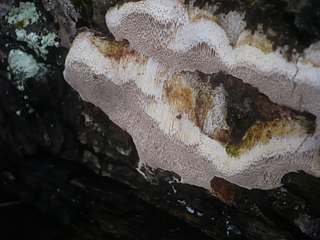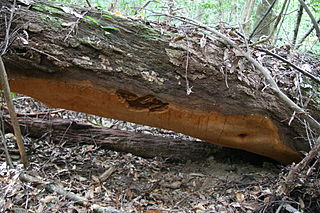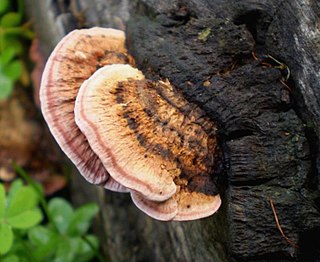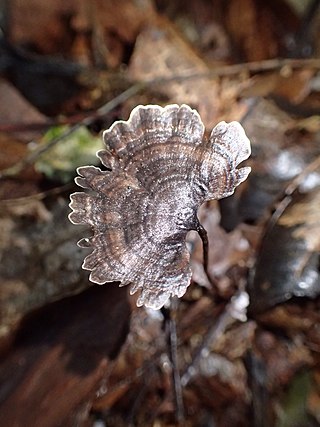
Shek Wing-cheung, better known by his stage name Shih Kien, Sek Kin, or Sek Gin or Shek Kin(Chinese: 石堅; pinyin: Shí Jiān; Jyutping: Sek6 Gin1), was a Hong Kong–based Chinese actor and martial artist. Shih is best known for playing antagonists and villains in several early Hong Kong wuxia and martial arts films that dated back to the black-and-white period, and is most familiar to Western audiences for his portrayal of the primary villain, Han, in the 1973 martial arts film Enter the Dragon, which starred Bruce Lee.
Abundisporus is a small genus of poroid fungi currently with seven recognized species. They differ from other polypores in having coloured rather than hyaline spores.
Abundisporus quercicola is a species of bracket fungus that grows on living oaks in temperate forests in the foothills of the Himalaya. The fruit bodies are perennial, grey to black above with concentric markings and white below. The fungus grows to 7 cm wide and 5 cm thick, projecting up to 5 cm from the substrate. The basidiospores are yellow.

Perenniporia is a cosmopolitan genus of bracket-forming or crust-like polypores in the family Polyporaceae. They are dimitic or trimitic with smooth, thick-walled basidiospores and cause a white rot in affected wood.
Perenniporia piceicola is a species of poroid crust fungus that is found on fallen spruce in Yunnan province, China. Basidiocarps are corky in texture, 5 cm (2 in) or more across with a characteristic pale yellow pore surface. The basidiospores are ellipsoid and hyaline and very large for the genus, up to 13 μm in length.

Haploporus is a genus of poroid fungi in the family Polyporaceae.

Skeletocutis is a genus of about 40 species of poroid fungi in the family Polyporaceae. The genus has a cosmopolitan distribution, although most species are found in the Northern Hemisphere. It causes a white rot in a diverse array of woody substrates, and the fruit bodies grow as a crust on the surface of the decaying wood. Sometimes the edges of the crust are turned outward to form rudimentary bracket-like caps.

Phellinus ellipsoideus is a species of polypore fungus in the family Hymenochaetaceae, a specimen of which produced the largest fungal fruit body ever recorded. Found in China, the fruit bodies produced by the species are brown, woody basidiocarps that grow on dead wood, where the fungus feeds as a saprotroph. The basidiocarps are perennial, allowing them to grow very large under favourable circumstances. They are resupinate, measuring 30 centimetres (12 in) or more in length, though typically extending less than a centimetre from the surface of the wood. P. ellipsoideus produces distinct ellipsoidal spores, after which it is named, and unusual setae. These two features allow it to be readily differentiated microscopically from other, similar species. Chemical compounds isolated from the species include several steroidal compounds. These may have pharmacological applications, but further research is needed.

Rhodofomitopsis lilacinogilva is a species of bracket fungus in the family Fomitopsidaceae. Known primarily from Australia, it has also been recorded from Brazil and India. It is a white-rot fungus that grows on rotting eucalyptus wood. Its main identifying feature is the lilac colour of the pore surface on the underside of the fruit body.

Wolfiporia curvispora is a species of fungus in the order Polyporales. It is found in Jilin, China, where it grows on the rotting wood of Pinus koraiensis. The fungus was described as new to science in 1998 by mycologist Yu-Cheng Dai. The fruitbodies of the fungus are resupinate, meaning they lie flat on the substrate, and have dimensions of up to 3 metres (10 ft) long by 70 cm (28 in) wide by 1 centimetre (0.4 in) thick. They are creamy white, soft, and light. The hyphal system is dimitic, comprising generative and skeletal hyphae. The specific epithet curvispora refers to the curved spores.
Skeletocutis brevispora is a species of poroid crust fungus in the family Polyporaceae. It was described as new to science in 1998 by Finnish mycologist Tuomo Niemelä.
Haploporus thindii is a species of poroid crust fungus in the family Polyporaceae. Found in China and India, it causes a white rot in woody substrates.
Skeletocutis luteolus is a species of poroid crust fungus in the family Polyporaceae. It is found in southern and eastern China, where it causes white rot.
Skeletocutis subvulgaris is a species of poroid, white rot fungus in the family Polyporaceae. Found in China, it was described as a new species in 1998 by mycologist Yu-Chen Dai. It was named for its resemblance to Skeletocutis vulgaris. The type collection was made in Hongqi District, Jilin Province, where it was found growing on the rotting wood of Korean pine.
Truncospora is a genus of 10 species of fungi in the family Polyporaceae.
Datroniella tropica is a species of crust fungus in the family Polyporaceae. Found in southwestern China, it was described as a new species in 2014 by mycologists Bao-Kai Cui, Hai J. Lee, and Yu-Cheng Dai, who placed it in the new genus Datroniella. The type collection was made in Tongbiguan Nature Reserve, where the fungus was found growing on a fallen angiosperm branch. The specific epithet tropica refers to its distribution in tropical China.
Perenniporia meridionalis is a poroid crust fungus in the family Polyporaceae. It was described as a new species by Cony Decock and Joost Stalpers in 2006. The holotype specimen was collected in the Province of Nuoro in Italy, where it was found growing on dead wood of Quercus ilex. Distinguishing characteristics of this fungus include its relatively large pores, the hyaline vegetative hyphae that are yellowish to slightly dextrinoid in Melzer's reagent, and large spores measuring 6.0–7.7 by 4.5–6.2 µm. P. meridionalis occurs in central and southern Europe, where it is found in warmer forested areas, usually on dead oak wood. It has also been reported to occur in North America.
Skeletocutis fimbriata is a species of poroid fungus in the family Polyporaceae. Found in China, it was described as new to science in 2008. The holotype collection was made in the Shennongjia nature reserve in northwestern Hubei province, where it was found growing on rotting angiosperm wood. The fungus is distinguished from the other Skeletocutis species by its narrow spores, and its coarsely fimbriate margin on the fruit bodies. The specific epithet fimbriata refers to this latter characteristic.

Perenniporia stipitata is a species of poroid fungus in the family Polyporaceae. Found in Brazil, it was described as a new species in 1987 by Norwegian mycologist Leif Ryvarden.

Nanhaipotamon is a genus of freshwater crabs, in the subfamily Potamiscinae, found in southern China and Taiwan. As of 2018, 18 species have been described. The genus is named after the South China Sea, for it occurs mostly in coastal areas. The genus was first described by R. Bott in 1968 as Isolapotamon (Nanhaipotamon), i.e., a subgenus of Isolapotamon.








